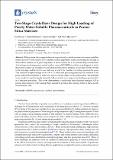| dc.contributor.author | Dwyer, Leia Mary | |
| dc.contributor.author | Kulkarni, Samir | |
| dc.contributor.author | Ruelas, Luzdary T. | |
| dc.contributor.author | Myerson, Allan S. | |
| dc.date.accessioned | 2017-10-31T14:17:32Z | |
| dc.date.available | 2017-10-31T14:17:32Z | |
| dc.date.issued | 2017-05 | |
| dc.date.submitted | 2017-05 | |
| dc.identifier.issn | 2073-4352 | |
| dc.identifier.uri | http://hdl.handle.net/1721.1/112090 | |
| dc.description.abstract | While porous silica supports have been previously studied as carriers for nanocrystalline forms of poorly water-soluble active pharmaceutical ingredients (APIs), increasing the loading of API in these matrices is of great importance if these carriers are to be used in drug formulations. A dual-stage mixed-suspension, mixed-product removal (MSMPR) crystallizer was designed in which the poorly soluble API fenofibrate was loaded into the porous matrices of pore sizes 35 nm-300 nm in the first stage, and then fed to a second stage in which the crystals were further grown in the pores. This resulted in high loadings of over 50 wt % while still producing nanocrystals confined to the pores without the formation of bulk-sized crystals on the surface of the porous silica. The principle was extended to another highly insoluble API, griseofulvin, to improve its loading in porous silica in a benchtop procedure. This work demonstrates a multi-step crystallization principle API in porous silica matrices with loadings high enough to produce final dosage forms of these poorly water-soluble APIs. | en_US |
| dc.publisher | MDPI AG | en_US |
| dc.relation.isversionof | http://dx.doi.org/10.3390/cryst7050131 | en_US |
| dc.rights | Creative Commons Attribution 4.0 International License | en_US |
| dc.rights.uri | http://creativecommons.org/licenses/by/4.0/ | en_US |
| dc.source | MDPI | en_US |
| dc.title | Two-Stage Crystallizer Design for High Loading of Poorly Water-Soluble Pharmaceuticals in Porous Silica Matrices | en_US |
| dc.type | Article | en_US |
| dc.identifier.citation | Dwyer, Leia et al. “Two-Stage Crystallizer Design for High Loading of Poorly Water-Soluble Pharmaceuticals in Porous Silica Matrices.” Crystals 7, 5 (May 2017): 131 © 2017 The Authors | en_US |
| dc.contributor.department | Massachusetts Institute of Technology. Department of Chemical Engineering | en_US |
| dc.contributor.mitauthor | Dwyer, Leia Mary | |
| dc.contributor.mitauthor | Kulkarni, Samir | |
| dc.contributor.mitauthor | Ruelas, Luzdary T. | |
| dc.contributor.mitauthor | Myerson, Allan S. | |
| dc.relation.journal | Crystals | en_US |
| dc.eprint.version | Final published version | en_US |
| dc.type.uri | http://purl.org/eprint/type/JournalArticle | en_US |
| eprint.status | http://purl.org/eprint/status/PeerReviewed | en_US |
| dc.date.updated | 2017-10-20T19:56:45Z | |
| dspace.orderedauthors | Dwyer, Leia; Kulkarni, Samir; Ruelas, Luzdary; Myerson, Allan | en_US |
| dspace.embargo.terms | N | en_US |
| dc.identifier.orcid | https://orcid.org/0000-0002-7596-3595 | |
| dc.identifier.orcid | https://orcid.org/0000-0002-5054-9080 | |
| dc.identifier.orcid | https://orcid.org/0000-0002-7468-8093 | |
| mit.license | PUBLISHER_CC | en_US |
| mit.metadata.status | Complete | |
